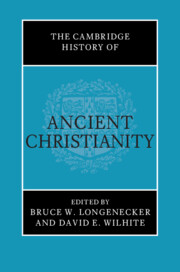Book contents
- The Cambridge History of Ancient Christianity
- The Cambridge History of Ancient Christianity
- Copyright page
- Contents
- Figures
- List of Contributors
- Editors’ Preface
- Part I Contested Contexts
- 1 The History of Ancient Christian History
- 2 The Present and Future of Ancient Christian History
- 3 Depicting the Other in Early Christian Polemic
- 4 Why Did People Become Christians in the Pre-Constantinian World?
- Part II Contested Figures
- Part III Contested Heritage
- Part IV Contested Cultures
- Part V Contested Beliefs
- Part VI Contested Bodies
- Ancient Sources
- Modern Authors
- References
1 - The History of Ancient Christian History
from Part I - Contested Contexts
Published online by Cambridge University Press: 23 August 2023
- The Cambridge History of Ancient Christianity
- The Cambridge History of Ancient Christianity
- Copyright page
- Contents
- Figures
- List of Contributors
- Editors’ Preface
- Part I Contested Contexts
- 1 The History of Ancient Christian History
- 2 The Present and Future of Ancient Christian History
- 3 Depicting the Other in Early Christian Polemic
- 4 Why Did People Become Christians in the Pre-Constantinian World?
- Part II Contested Figures
- Part III Contested Heritage
- Part IV Contested Cultures
- Part V Contested Beliefs
- Part VI Contested Bodies
- Ancient Sources
- Modern Authors
- References
Summary
When was the first history of ancient Christianity written? The answer of course is not so simple. For instance, one may think of Eusebius’s Historia ecclesiastica (c.324) as the first account of ancient Christian history, covering the time of Christ up until the time of Constantine. However, the term historia in Eusebius’s title implies “narrative” more than a modern notion of “what happened.”1 In other words, much depends on what is meant by the category of ancient Christian history, and so debate ensues about the nature of studying this subject.
- Type
- Chapter
- Information
- The Cambridge History of Ancient Christianity , pp. 3 - 31Publisher: Cambridge University PressPrint publication year: 2023



